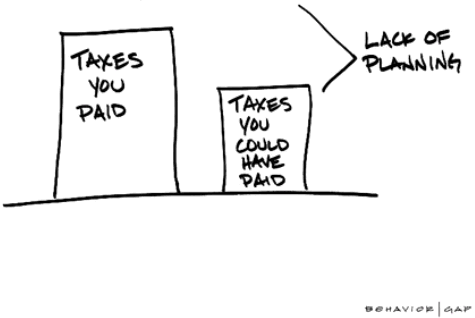Tax Planning: Principles
Oct 14, 2022 • Written by Paul Staib | Certified Financial Planner (CFP®), MBA, RICP®
Blog Home » Tax Planning » Tax Planning: Principles

Tax planning is (or certainly should be!) a core, vital component across all financial and retirement plans. There’s tax implications to virtually every part of someone’s financial life. Everyone – regardless of income, net worth, or size of investment portfolio – can benefit from tax planning and who wants to pay more tax than the minimum required to pay under the law! In this post, we’ll discuss a few important principles regarding tax planning.
Importance of Tax Planning
Before getting into specific principles, let’s start with a few foundational items regarding why you should care about tax planning and why it’s so important.
Efficient Financial / Retirement Planning
I often discuss the importance of EFFICIENT PLANNING. At its core, efficient financial or retirement planning means making the most of your given resources; you’re maximizing the usage of them to achieve your personal financial goals. For example, for retirees’, you may be eligible for a pension, you’re entitled to social security income, and you have savings and investments accounts … efficiency refers to utilizing those resources as best as possible – in a coordinated and cohesive manner – to achieve your personal financial goals. It’s important to understand how each component of your retirement income is taxed.
Unquestionably, the biggest opportunity I find for improving the EFFICIENCY of plans is through good TAX PLANNING; that is paying as little tax as possible under the law. TAX PLANNING is a significant part of having an EFFICIENT FINANCIAL / RETIREMENT PLAN.
Immediate and Demonstrable Value to be Gained
The actual savings over time resulting from good tax planning is often times in the hundreds of thousands of dollars! The potential benefits to be realized are tangible and often times immediate. There is significant opportunity by including tax planning as part of your retirement plan.
Everyone can Benefit from Tax Planning … “Common Enemy”
And the opportunity isn’t limited to just people with high incomes, high net worths, or with multi-million dollar investment portfolios; everyone can benefit from good tax planning. The goal of paying as little tax as possible under the law is THE common goal across all people. Paying more in taxes than required results in unnecessary leakage from your plan, with resources going to Uncle Sam instead of towards the achievement of your personal financial goals – INEFFICIENT!
The diagram by Carl Richards from the Behavior Gap does a great job of summarizing the value of tax planning. Why pay more in tax than you have to?
Tax Planning: Key Principles
With that background information covered, let’s now dig into the key Principles of Tax Planning:
Principle #1: Lowest Lifetime Tax Bill Wins
The OBJECTIVE OF TAX PLANNING IS TO MINIMIZE your total taxes OVER THE LONG-TERM; the goal is NOT to minimize taxes in any 1 given year, or just for few specific years.
As such, when performing tax planning, it’s important to look out into the future and plan for the long-term – which often times is measured in decades, such as with a potential 20-40 year retirement plan. Paying no or very little taxes in any given year may make you feel great in that moment – but almost always it’s a result of taking a short-term viewpoint – just looking at the current year or the next few years and not planning very far into the future.
For retirees, low-income years are often the years when you first retire, or transition to part-time work, before starting Social Security and being subject to required minimum distributions (RMDs). And once these low-income years pass, you can’t go back in time and get them back. LOW TAX BRACKETS ARE A TERRIBLE THINGS TO WASTE!
The GOAL is to PAY TAXES WHEN THE RATE IS THE LOWEST!
To the extent that you can control the timing and amount of income and the associated taxation of it – you want to pay the tax when the rate is the lowest. Roth conversions, saving in pre-tax or Roth 401ks, charitable contributions – these are all levers or strategies which may enable you to control the timing of when income is taxed.
Takeaways regarding principle #1:
- Tax planning requires forward looking, long-term planning AND
- the goal is PAY TAX WHEN THE RATE IS THE LOWEST!
Principle #2: There is No Such Thing As “Permanent”
Regarding TAXES, there is no such thing as permanent; permanent does not exist.
There are 2 general categories of tax laws:
- Rules that we know when they are scheduled to change or sunset, and
- Rules that are not scheduled to change, and are written as “permanent”, but permanent means until congress decides to change it
“The tax code is written in pencil, not in ink, and it’s certainly not in permanent marker“
We’re experiencing right now a great example of tax law with a sunset – the TCJA (tax cut and jobs act) of 2017 was a MAJOR overhaul to tax legislation. It included changes to the treatment of standard deductions, tax bracket rates, size of the tax brackets, elimination of personal exemptions, among much more. It’s estimated that ~90% of TCJA is set to expire at the end 2025: with much of it is set to revert back to pre-law conditions. The TCJA is an excellent example of law with a sunset, a defined end. Other tax laws are in place (“permanent”) ONLY until congress decides to change them.
When performing tax planning, its important to realize the tax laws are subject to change and future unknowns. But that stated, you must perform planning based on the current knowns, while also staying abreast of the ever-evolving tax rules. Tax/planning strategies which are appropriate today may NOT be appropriate or optimal tomorrow – must use that as the lens through which tax planning is done.
Principle #3: Tax Rate does NOT = Tax Bracket
There are numerous occasions where you may be in a lower tax bracket, but have a higher tax rate OR conversely, be in a higher tax bracket, but have a lower true tax rate at different points in your life.
You may say “how is that possible”… and its possible as a result of several things:
There are deductions and credits for instance that you may have at different points in your lives that only exist for a certain number of years: examples: child tax credits, education tax credit such as the American Education credit – only available for a certain limited number of years. There are many things that are only available during certain portions of your life; and while you may be in a lower tax bracket earlier on, if your income is increasing you may reduce – or lose – your ability to otherwise receive a tax credit.
Tax Torpedos
These scenarios are often referred to as Tax Torpedos. The most famous of the Tax torpedos is with Social Security. There are situations where the Social Security tax formula adds more social security income to a retirees tax bill for every dollar of income that you actually receive. A retiree, if they have very little or no other income besides Social Security, may have $0 of their Social Security taxable. But if they have a significant amount of other income, up to 85% of their Social Security income can be subject to tax.
So the range is from 0% up to 85%. So what happens is along the way is increases in your income causes Social Security to be taxed, so an additional $1 of taxable income causes up to an additional $1.85 to be taxed (the $1 of taxable income + $0.85 of social security income), and if the retiree is in the 22% tax bracket, that additional $1.85 taxed at 22% = 40.7% effective tax rate. So in this example, that additional $1 of income for someone in the 22% TAX BRACKET, resulted in a 40.7% effective tax rate!
This is a rather egregious example, but it illustrates Principle #3: your Tax Rate often times does not equal your Tax Bracket and you need to be aware of, and ideally plan around, these tax torpedoes.
Principle #4: Tax Diversification is a Byproduct, Not a Goal
Tax diversification refers to having your investments spread across the three different types of accounts: Tax-deferred accounts (i.e. 401k, traditional IRAs), tax-free accounts (i.e. Roths), and taxable brokerage accounts. Tax diversification is a useful BYPRODUCT of the choices that you make along the way, but it is NOT a goal, in and of itself.
Tax diversification sometimes happens, and sometimes it does not happen.
You don’t NEED tax diversification, though it can be useful and valuable, providing more flexibility for overall efficient planning and tax planning. But again, don’t forget Principle #1 – the GOAL regarding taxes is to pay tax when the rate is the lowest! Don’t worry about tax diversification – that comes as a byproduct of good decisions made along the way.
Summary
Towards the end of the accompanying video, I’ve provided an example / case study which illustrates several of these tax planning principles which resulted in a projected ~$430k savings in taxes! Tax planning should be a core component of every financial / retirement plan. Good tax planning requires a long-term perspective, and invariably results in a more comprehensive and efficient plan. With tax planning, remember the goal is to PAY TAX WHEN THE RATE IS THE LOWEST!

Paul Staib | Certified Financial Planner (CFP®), MBA, RICP®
Paul Staib, Certified Financial Planner (CFP®), RICP®, is an independent Flat Fee-Only financial planner. Staib Financial Planning, LLC provides comprehensive financial planning, retirement planning, and investment management services to help clients in all financial situations achieve their personal financial goals. Staib Financial Planning, LLC serves clients as a fiduciary and never earns a commission of any kind. Our offices are located in the south Denver metro area, enabling us to conveniently serve clients in Highlands Ranch, Littleton, Lone Tree, Aurora, Parker, Denver Tech Center, Centennial, Castle Pines and surrounding communities. We also offer our services virtually.
Read Next
How to Minimize Taxes of Social Security Benefits
• Written By Paul Staib | Certified Financial Planner (CFP®), MBA, RICP®
Many people are surprised to find out their Social Security income is subject to taxes in retirement. There are a…
6 Strategies to Reduce Taxes in Retirement
• Written By Paul Staib | Certified Financial Planner (CFP®), MBA, RICP®
For many people, reducing taxes is the easiest and fastest way to increase investment returns, keep a retirement plan back…
